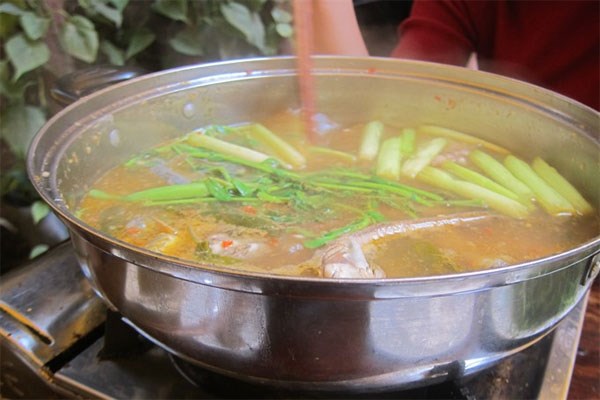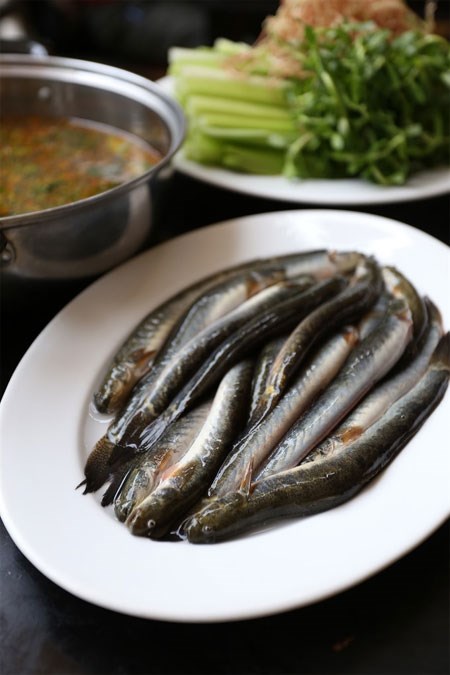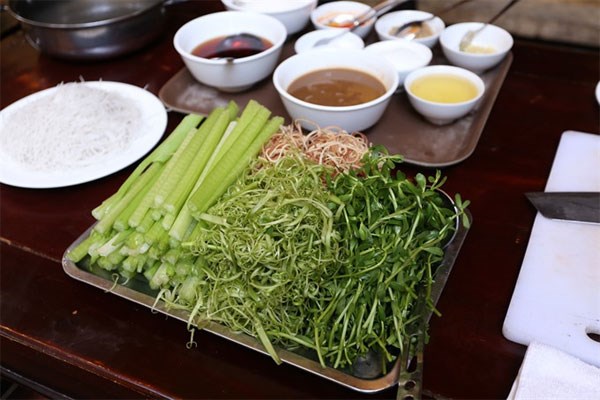
Keo fish hotpot impresses diners with its delicate broth, aromatic fish meat and characteristic vegetables of the rural south. —VNS Photo Hong Nhung
The
aromatic, juicy Ca keo (pseudapocryptes elongatus), one of the southerners’
favourite fish, is used for grilling and hotpot. “Keo fish hotpot originates in the south of
Viet Nam and has been one of the highlights of the southern rural kitchen,”
said culinary expert Le Kim Chi from the Quan An Ngon restaurants chain.
Keo
fish is a type of catfish the size of about two fingers and about 15 cm long
when it is mature. This fish is found mostly in Soc Trang, Bac Lieu and Ca Mau
provinces.
Writer
and journalist Phan Trung Nghia from Bac Lieu Province once wrote: “In the
early 19th century, Bac Lieu was a characteristic province of the Mekong River
Delta with scores of rivers, streams and cannals. Many rivers stemmed from the
sea, therefore there was an abundance of seafood there.
“In
the lead-up to the Tet (Lunar New Year) holiday, when slightly cold weather
comes, keo fish season begins. In local cannals and rivers, keo fish is so
abundant that the fish heads emerging from the water look like dense black
spots on the surface of water.
“Keo
fish grow very quickly. It is as thin as a toothpick at the beginning of the
rainy season and becomes as big as a thumb at the end of the season. At that
time, a day’s catch could reach 500 to 700 kilogrammes of keo fish, so much
that no boat was big enough to store them,” wrote Nghia.
The
fish has since become a favourite of not only people in the south but also food
connoisseurs in Ha Noi, said Chi.
Chi
has brought many southern dishes, including keo fish hotpot, to her Quan An
Ngon restaurants in Ha Noi. “Hanoians fall for this dish very quickly,” she
said.
To
make authentic keo fish hotpot, Chi, like other cooks, has to import keo from
the south and keep them alive until they are cooked. “The prerequisite
requirement for this dish is for the fish to be fresh and live,” said Chi.
“Fish
is to be eaten a few minutes after being put in the broth because this type of
fish is small and long and therefore it is cooked very quickly,” said chef
Nguyen Xuan Luyen from Quan An Ngon.
As
keo fish do not have anterior dorsal fins, they don’t have little bones.
Despite its unattractive look, the fish meat is delicious — being soft in
texture and having a unique aroma of a fish living in nature, an aroma that is
rarely present in frozen fish.
Normally,
when cooking fish, Vietnamese people add seasonings or specific types of
vegetables to reduce the fishy smell, for example pepper, rau ram (Vietnames
coriander) or pineapple or dam bong (rice wine residue). “In ca keo hotpot,
locals use their la giang (river-leaf creeper) and tamarind, which help to add
sourness. Some replace tamarind with either lemon or vinegar, yet these two are
not a good choice as lemon may cause a bit of sourness when it is added to hot
water while vinegar is not as delicate as tamarind,” said Luyen.
Therefore,
there is no fishy smell in the broth. Instead, the first whirl of steam from
the boiling broth will make diners’ mouth water. Taking a first sip of broth is
never enough, arousing curiosity and a desire for more of the slightly sour,
salted, sweet and a bit garlicky meaty fish.
The
ingredients and preparation of Vietnamese hotpots are simple: broth made by
simmering pork bone, (different types of) meat, various kinds of vegetable and
vermicelli noodles with broth at the end of the meal. While lau bap bo (beef
thigh hotpot) features the tenderness of beef, the seafood hotpot indulges
diners with the sweet meaty broth, lau mam (salted fermented fish hotpot)
features the pleasantly pungent and characteristic aroma of salted fermented
fish, keo fish hotpot impresses diners by its delicate broth, aromatic fish
meat and characteristic vegetables of the rural south.
The
keo fish hotpot broth is made by simmering pork bone with la giang (river-leaf
creeper) which tastes sour and has a good aroma. Other vegetables served in
this hotpot include rau dang (bitter vegetable), banana flower, keo neo (yellow
burrhead), water lily and water spinach. Locals also cook keo fish with pepper
or rau ram (Vietnamese coriander), or grill the fish with chilli and salt.

Despite its unattractive look, the fish meat is delicious — soft in texture and with a unique aroma of fish living in nature, rarely found in frozen fish.—Photo Courtesy of Quan An Ngon

Characteristic vegetables used in keo fish hotpot include rau dang (bitter vegetable), banana flower, keo neo (yellow burrhead), water lily and water spinach. —Photo Courtesy of Quan An Ngon
Lau ca keo is served
at:
Ha
Noi:
Quan
An Ngon Restaurants
18
Phan Boi Chau Street, Ha Noi. Phone: 04 3942 8162
34
Phan Dinh Phung Street, Ha Noi. Phone: 04 3734 9777
Floor
1, 25T2 Hoang Dao Thuy Street, Ha Noi. Phone: 04 3556 0866
B2
Vincom Royal City, 72A Nguyen Trai Street, Ha Noi. Phone: 04 6664 0066
Phuong
Nam Restaurant, Number 2, Alley 69 of Chua Lang Street, Ha Noi.
HCM
City:
87
Ba Huyen Thanh Quan Street, District 3, HCM City.
4
Nguyen Thi Dieu Street, District 3, HCM City. Phone: (08) 3933 0696
By Hong Van/VNS